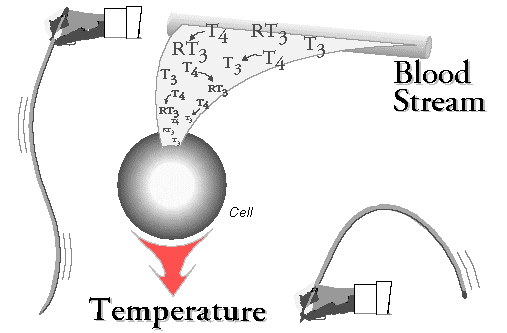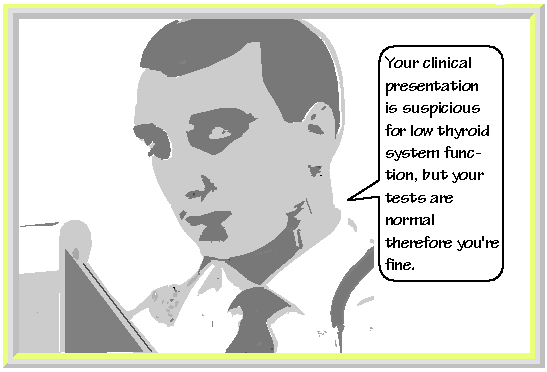The body temperature is a result of the thyroid stimulation of the cells. Trying to manage a patient on thyroid medicine using only thyroid blood tests as a guide is a little like trying to write your name with a floppy pencil.
Thyroid blood tests measure the hormone levels in the blood stream. Thyroid hormones do not have their activity in the blood stream, however, but in the cells of the body.
Currently, there is no way to measure directly what is happening outside the confines of the blood stream, especially at the level of the nuclear membrane receptors.
Body temperature patterns correlate far better with a person’s low thyroid symptoms, than do thyroid blood tests, because rather than trying to estimate what might happen at the cell, they better reflect what has happened in the cells of the body.
Note: Imagine you were trying to write your name with a rubber pencil that was 3 feet long, while holding the end away from the point. You could press down, but it might wiggle this way, or that, and be hard to manage. But if you held it down by the point, you’d have a lot better chance of being able to read your name when you were done. Likewise, when doctors make sure T4 levels look about right on the blood tests, that T4 may get converted to T3 (which is 4 times more active than T4), or it might get converted to RT3 which is totally inactive. How much goes one way or the other can change readily (on the order of days or perhaps even hours) depending on the circumstances. Managing patients while taking body temperature patterns into account is like holding the pencil down by the point.
Although it is common practice, it is not proper to give thyroid medicine without regard to body temperature patterns. Body temperature patterns are what correlate the best with the symptoms.
Evaluation or management that does not take body temperature patterns into account could not be considered thorough or conscientious.
The adage “Treat the patient, not the blood tests,” reminds us to consider what might be wrong with the patient, and to not jump to faulty conclusions by taking the meaning of blood tests out of context. After all, clinical observations are the gold standard used to establish the utility of thyroid tests in the first place.
We must remember that the usefulness of thyroid blood testing has been determined in the first place based on clinical information.
Note: The studies that established TSH (including 3rd generation TSH assays) as the most sensitive indicator for thyroid gland function, took a number of clinically hypothyroid patients and a number of clinically euthyroid patients and measured their thyroid blood test indices and stratified them to see which blood test correlated best with the clinical observations.
It is illogical to base the value of the biochemical tests on clinical parameters, and then to turn around and say that the biochemical tests are more reliable than clinical parameters.
And besides, all tests have false negatives and false positives, and therefore are not necessarily conclusive.
Note: See Limitations of Tests in General (page 50) and Limitations of Thyroid Blood Tests (page 55) of the book Wilson’s Temperature Syndrome–A Reversible Thyroid Problem (4th edition), for a thorough discussion about how there is far greater variation in thyroid blood tests than in body temperature patterns and why that’s important.
The true value of a test is how predictive it is. The predictive value of clinical presentation, response, and body temperature patterns make them excellent and irreplaceable guides to managing thyroid treatment.
In a sense, everything in medicine is a therapeutic trial.
For example, one of, if not the most widely prescribed medicines in the world (an antidepressant) is prescribed and managed solely on a clinical basis.
And it has been said that as much as 80% of medical diagnoses are made on clinical parameters.
It’s not surprising doctors rely so heavily on clinical presentation, response, and judgment-it’s the mainstay of the profession.
The question is, when it comes to the area of thyroid, how did doctors ever get so preoccupied with the blood tests in the first place?
The problem has been that doctors have been concentrating only on the problems affecting the glandular portion of the thyroid system which they were able to correct well using blood tests as a guide, but when the tests were normal they (not surprisingly) were not able to improve low thyroid system symptoms reproducibly with the treatment they were using. And since they did not have the principles of management recently developed (for Wilson’s Temperature Syndrome), nor body temperature as a guide, they had virtually no way of monitoring treatment and consequently, more commonly encountered problems. Thus, generating very little benefit on one hand and some problems on the other, they gave up on the possibility that some people with normal tests might greatly benefit from thyroid treatment, and decided/pretended it didn’t exist.



